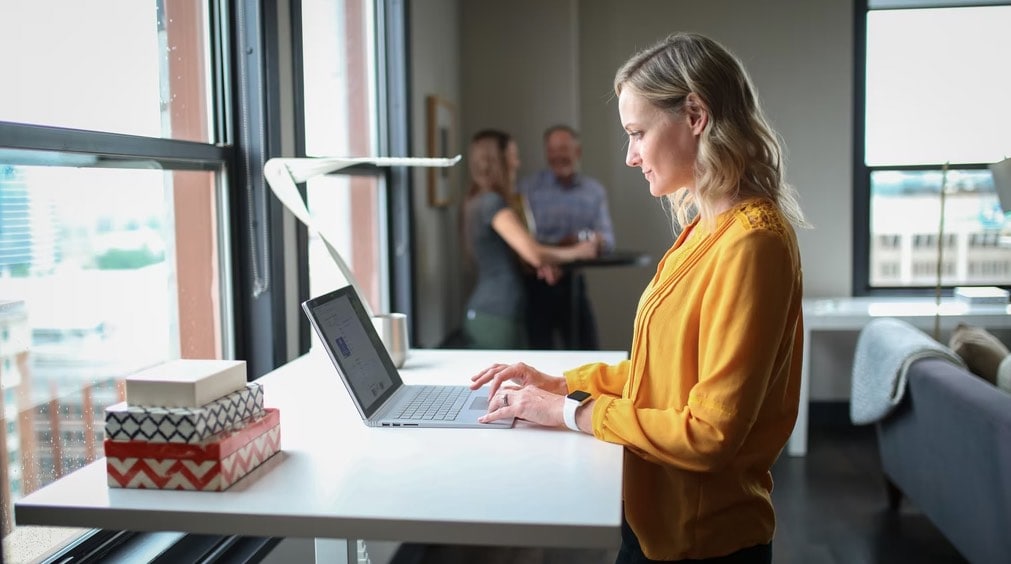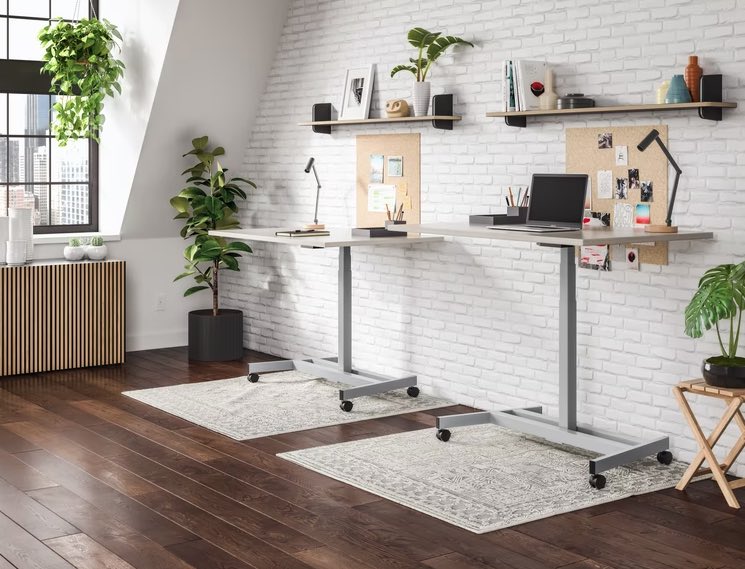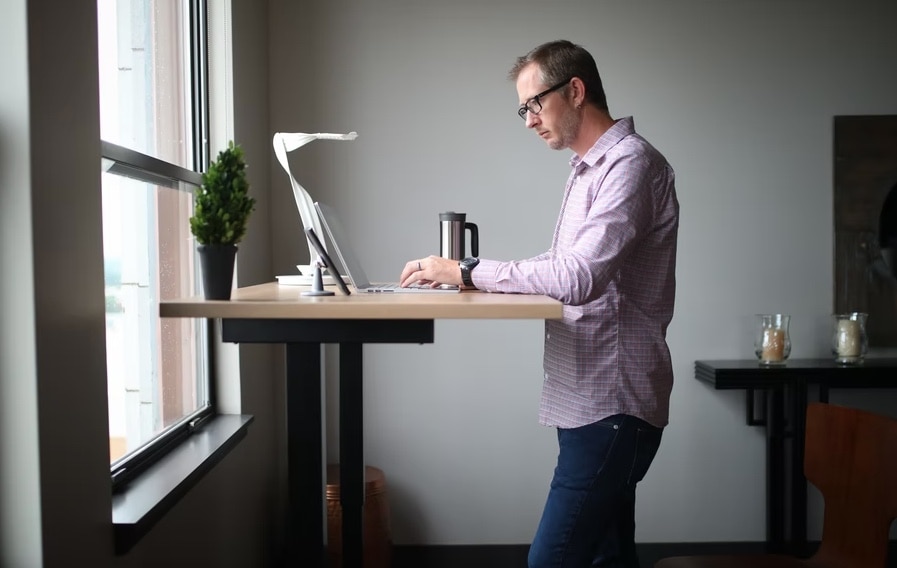Working in confined spaces can be difficult, and this is especially true for individuals who require a desk in their workspace. You want it to be large enough to accommodate your computer monitor and any other essential items, but you also want it to be as compact as possible so that the remaining space on the floor can be used for something else.
The best choice you can make for a limited amount of room is to go with a desk that is on the smaller side. Not only will it save you money, but it will also spare you the hassle of searching for hours on end for the ideal piece of furniture that will fit in the space available in your room.
If you are attempting to get organised, it is recommended that you look for desks that include storage space, such as drawers, shelves, or even spaces underneath the surface of the desk itself. Finding the right size for your space is the most important consideration when purchasing one, so make sure to take some measurements before heading out to the store.
The process of selecting a desk, much alone zeroing down on the ideal measurements, entails a wide range of considerations. There are a number of considerations to make when purchasing a desk, including the available space, the intended purpose of the workstation, and your prefered manner of working.
We thought it may be helpful to answer some frequently asked questions concerning standing workstations for compact areas. We hope this will help you find the perfect desk for your home or office.
Working in confined spaces can be difficult, and this is especially true for individuals who require a desk in their workspace. You want it to be large enough to accommodate your computer monitor and any other essential items, but you also want it to be as compact as possible so that the remaining space on the floor can be used for something else.
The best choice you can make for a limited amount of room is to go with a desk that is on the smaller side. Not only will it save you money, but it will also spare you the hassle of searching for hours on end for the ideal piece of furniture that will fit in the space available in your room.
If you are attempting to get organised, it is recommended that you look for desks that include storage space, such as drawers, shelves, or even spaces underneath the surface of the desk itself. Finding the right size for your space is the most important consideration when purchasing one, so make sure to take some measurements before heading out to the store.
Choosing a desk, let alone determining the optimal dimensions for it, involves a significant number of factors that must be taken into account. You should consider a number of factors before you go out and buy a desk, including the amount of space you have, the desk's intended use, and your prefered working method.
We thought it would be beneficial if we looked at some of the most popular standing desks for tiny rooms and gave you some advise that is both practical and helpful because we receive a lot of queries about them. We hope this will help you find the perfect standing desk for your home or office.
Is There a Recommended Desk Height?
Because they feel the height and breadth of the desk are more crucial, people occasionally don't give the depth of the desk the same attention. However, your desk's depth is crucial to ensuring you have enough space to work and enough for equipment.
Your workstation should have a minimum width of 610 millimetres and a maximum depth of 762 millimetres. The desks in the Home Work collection are the narrowest we provide; yet, it is always preferable to have more space than too little. The 600 mm depth across the board for this collection of workstations means they are ideal for spaces with restricted depth.
For efficient typing and computer work, a desk depth of 712 to 762 millimetres is recommended. You may more effectively organise your workspace and have room for all of your workstation necessities if you do this.
Our regular desks are 800 mm deep, which is the maximum depth for an office desk. All of your computer components will fit on your desk, and you'll be able to find a comfortable working position for your keyboard and mouse.
If you plan on using under-desk or desk-high storage, measure its depth to ensure it won't stick out past the desk's surface. Similarly, if your desk's storage is too narrow, you can have trouble getting to the things you need when you're at your desk.
Invest in a Desk That Maximises the Most of the Space Available
If your home does not have a built-in desk, you will need to acquire a sturdy stand-alone desk to house your computer, printer, and other home office necessities. Try to find desks that will allow you to maximise the available space in your office.
Whether you're looking for a writing desk that can be pushed up against the wall, an L-shaped desk that can fit in the corner of a bedroom, or a floating desk that frees up floor space, make sure to buy the desk that will function the best in your house.
To What Width Should I Set My Office Desk?
You should have at least 610 millimetres of desk space available, as was just specified. Smaller than this, it will be tough to use for almost anything.
Before buying a desk, you should consider how frequently you will use it, what you will need to put upon it, and where you will place it. Using your desktops for long amounts of time may require a bigger desk.
Buying a smaller desk plus a storage pedestal or filing cabinet that is desk-high will help you make the most of a limited amount of space in your office. Placing the shelves next to your workstation will give you more area to spread out while also giving you more storage for your computer accessories.
All of our workstations are available in a variety of widths to accommodate the needs of our customers. For comparison's sake, our regular office desks range in width from 800mm to 1800mm, while the Home Work desks' widths are between 790mm and 1155mm.
How Does One Choose A Desk Appropriate For A Small Space?
Small Proportions
If you have to cram your desk into a corner next to an existing potted plant, there is no way you can justify purchasing a desk that is 1500 millimetres long, no matter how helpful it might be.
The width range of 1000–1300 millimetres is typically considered optimal for small desks. If you make it any narrower, your desk runs the risk of becoming unsuitable for its intended use; if you make it any wider, you'll have a desk that's suitable for a large room.
Available Space
If you have limited room, choose compact desks like a computer or writing desk.
The office shouldn't be jam-packed with furniture, because people need to be able to move around and there should be space for other decorations.
Keep It Spacious
The tendency for a space to become cluttered increases as its size decreases. If you feel like your space is already cluttered enough, the last thing you want to do is add a heavy desk and start triggering people's claustrophobia by making the space feel even more cramped!
Combining a desk with the bare minimum of accessories with an open bookcase is one strategy for decluttering a space. This way, you won't have to worry about your limited space becoming cluttered while still benefiting from an abundance of storage and functional working space.
Avoid Using A Big, Bulky Office Chair
When putting together a home office in a limited amount of space, it is essential to make the most of the available work area as much as you can. You are able to accomplish this by selecting a chair for your office that can easily slide under the desk.
Avoid using wide, cumbersome office chairs with armrests if at all possible. Rather than that, selecting a desk chair that can also serve as a dining chair or a sitting chair may be an additional fantastic way to conserve space in a house with limited living quarters.
Clever Storage
If you only have one room to yourself or if you live in a studio, the chances are that you've already had to come up with ingenious storage solutions for your belongings. In the case of the desk, storage is not merely a matter of convenience; rather, it is a matter of necessity, which is especially important to keep in mind if you are a student who attends school full-time.
When organising a home office, you shouldn't plan on having a lot of spare room on the ground for storing things. Instead, you should put your attention on vertical storage. Consider installing shelves above your desk as an alternative to file cabinets so that you have space for storing files, books, pens, and other office supplies. Consider purchasing a free-standing ladder desk that has vertical shelves.
This will allow you to avoid nailing anything into the wall. These desks are designed to save floor space by leaning against the wall. They also include a writing surface and sufficient shelving to store a variety of office supplies.
Therefore, you ought to carefully assess your requirements. Have you worked out the kinks in your system for storage? If this is the case, you probably don't need any more than one desk drawer, and you can probably get away without having one at all. Alternately, if you don't have a lot of extra space for handy storage items, you might want to think about getting a desk that has two or three roomy drawers in it.
Your desk needs to have storage compartments, regardless of how large or small it is. Even though there might be a chest of drawers or storage cabinets in the room, you still need to keep certain office supplies within easy reach. Therefore, you should purchase a desk for your office that has a few drawers on it so that you can store essential supplies such as pens, staplers, and papers.
Expert advice: if you are taller or wider than the average person, test out your desk in the store to make sure there is enough leg room for you. This is especially important if you work at a computer.
Surface Area
Because of the dimensions of the room, you might not be able to get a particularly roomy executive desk. Despite this, you still need a desk that provides sufficient space for you to place all of your various office supplies. Consider the computer, the files, the paper tray, the pictures of your loved ones, and the flower vase you treasure. You, your personality, and the things that are most important to you should all be reflected in your desk.
Quality
When you are in the market for new office furniture, you should always make sure that the pieces you purchase are of a high quality. Otherwise, you will have to keep buying new furniture every year. Your spending plan shouldn't be so tight that it hurts your back, but it should still be reasonable enough to allow you to purchase a good desk. Hardwoods like mahogany are used in the production of high-quality goods that have a long lifespan.
Keep Your Workspace Simple And Decluttered
Are you trying to work right now? De-cluttering your work area and maintaining a consistent tidy desk routine will help you keep things straightforward. Consider keeping only your computer, keyboard, mouse, picture frame, and lamp in your room as personal items.
The addition of an excessive number of personal items to your office will only serve to distract you from your work and reduce the amount of available desk space that you have to utilise.
When a Small Standing Desk Is All That Is Needed?
There are situations where a 30-inch deep standing desk might be too large, and a 28-inch or even smaller desk would be more appropriate. This is because this is the standard depth of standing desks on the market.
If you're a laptop user with little space in your Manhattan apartment, dorm room, or "hot desk" location and don't plan on using many external monitors, one of these desks is perfect for you. Any of those settings would be suitable for one of these desks.
We've listed all of the most popular alternatives for shallow depth standing desks (varying from 23.5 inches to 28 inches) to make it easier for you to get the best small standing workstation.
Important Factors to Assess Before Purchasing a Small Adjustable Height Desk
Compared to a standard-sized desk, the selection of shallow desks is noticeably slimmer. Despite this, there are still a few important factors to think about when making your purchase due to the lower size.
One of the primary factors to think about is the variety of desktop widths that are offered. Given that your depth limits the size of the desktop you can use, it's important to find the broadest one possible. Depending on the design, the maximum width for this is usually between 30 and 71 inches.
Make sure you think about the desk guarantees, too.
Whatever your motivation, our selection of the best desks for tiny spaces will help you maximise a constrained space (have more space to work with? Instead, you should check out our comprehensive guide to the best desks.
If you select the appropriate pieces of furniture, you might be surprised at how much you are able to fit comfortably into a corner of a box room or a lounge. Be sure to pick up one of the most comfortable office chairs while you're out shopping for the rest of your office furniture. Now, keep reading for some creative space-saving ideas that we've incorporated into our list of the best workstations for tiny spaces.
Conclusion
Finding the right size for your space is the most important consideration when purchasing a desk. The process of selecting a desk, much alone zeroing down on the ideal measurements, entails a wide range of considerations. We hope this will help you find the perfect desk for your home or office. Finding the right size for your space is the most important consideration. Our desks are 800 mm deep, which is the maximum depth for an office desk.
If you plan on using under-desk or desk-high storage, measure its depth to ensure it won't stick out past the desk's surface. You should have at least 610 millimetres of desk space in your office. Smaller than this, it will be tough to use for almost anything. Buying a smaller desk plus a storage pedestal or filing cabinet will help you make the most of your office space. The tendency for a space to become cluttered increases as its size decreases.
Avoid using heavy, cumbersome office chairs with armrests if at all possible. Consider installing shelves above your desk instead of file cabinets so that you have space for files, books, pens, and other office supplies. You, your personality and the things that are most important to you should all be reflected in your desk. Therefore, you ought to carefully assess your requirements for office furniture. Your spending plan shouldn't be so tight that it hurts your back, but reasonable enough to allow you to purchase a good desk.
There are situations where a 30-inch deep standing desk might be too large. This is because this is the standard depth of standing desks on the market. We've listed all of the most popular alternatives for shallow depth standing desks (varying from 23.5 inches to 28 inches).
Content Summary
- The best choice you can make for a limited amount of room is to go with a desk that is on the smaller side.
- Finding the right size for your space is the most important consideration when purchasing one, so make sure to take some measurements before heading out to the store.
- Try to find desks that will allow you to maximise the available space in your office.
- Select a chair for your office that can easily slide under the desk.
FAQs About Desks
You should buy a desk with dimensions that serve your usage most appropriately. A standard large desk size that will suit most uses is 60-inch x 30-inch, with a height 30-inches. These dimensions will comfortably accommodate most general use cases and should be used as a baseline.
Place your desk as close to a natural light source as possible. You should also place your desk as close to a natural light source as possible. Some like to face the window, but if that proves too distracting, put the desk perpendicular to it.
Although there's no standard size for typical desks, they are commonly 48, 60, or 72 inches wide and 24, 30, or 36 inches deep, according to Houzz. A great small desk would have smaller dimensions but still provide enough space for at least a laptop.
Desks that can be adjusted to a variety of heights are thought to boost employee productivity in addition to providing health benefits.
According to a study done by Work, 65 percent of people who had height-adjustable desks reported increased productivity after one year. These same people also reported improved ability to concentrate.




